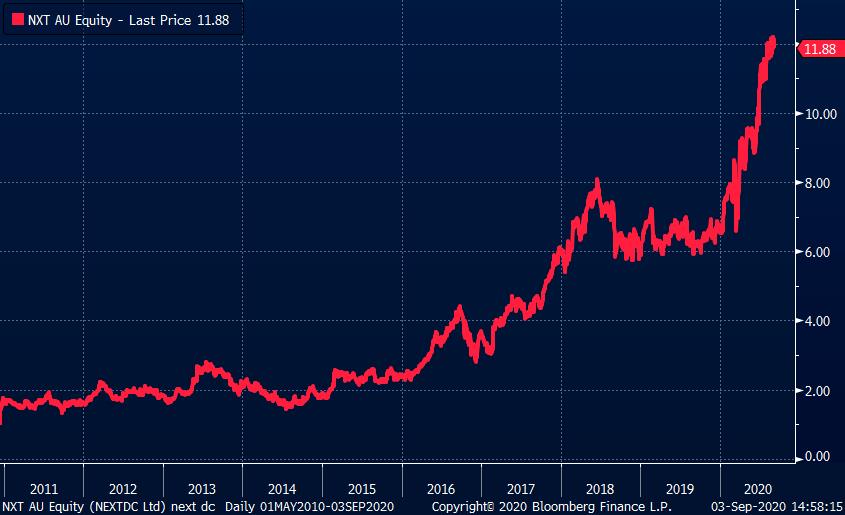Zero to Hero: How NextDC went from start-up to $5.5b stock in 10 years

In 10 years NextDC (ASX:NXT) has grown another start up of Bevan Slattery's to a $5.5b ASX 200 company
NextDC (ASX:NXT) boasts a decade few other ASX companies have experienced, going from a start-up to a $5.5bn company.
NextDC operates data centres which makes anything in the digital world from social media to online shopping possible.
Naturally, demand for data centres has exploded over the last decade, especially during the COVID-19 pandemic with the rapid shift to doing everything online.
But wind the clock back 10 years and the company was just another Bevan Slattery start up.
Slattery, a famous tech entrepreneur, co-founded Pipe Networks back in 2002 and sold it to TPG in 2010 for $373m. He used the proceeds to start NextDC.
Slattery ended up leaving NextDC in 2013. But current boss Craig Scroggie says the company is one Slattery is proud of and validates his vision.
“He and I still talk regularly. He has a lot of pride in what he started and has a passion for seeing the company continuing to be successful,” Scroggie told Stockhead.
“I think when you’ve got someone that had such a great vision, from my perspective it’s wonderful to go on and continue to grow the company successfully and deliver on many of the things he envisioned that we’d be capable of doing, and do that in a way that demonstrated his vision was really a great insight into the future.”
Start-up & ASX entrant in the same year
NextDC began in May 2010 then listed only a few months later in December of that year. It listed at $1 per share, a far cry from the $11.88 it traded at on Thursday.

“The business really started its life early on as a listed company whereas many others start public life after years or even decades of being private,” Scroggie said.
“And it’s really the difference between why do businesses go public [or stay private], what is the key driver for going public? In a new business sense it can be getting access to the type of capital required.
“I think Bevan recognised early on infrastructure businesses they don’t require tens of millions, they require hundreds of millions – and as it turns out 10 years on that’s billions of dollars invested.”
But Scroggie noted it was tougher to raise that money privately a decade ago.
“When you’re going to build a large-scale business like ours that’s capital intensive, you have to invest in the infrastructure at the beginning and Bevan chose the path to be listed,” he said.
‘Pay-as-you-consume computing’ wherever you need it
In those days there were only a handful of data centre operators outside the major telcos. But Slattery and those who helped him start NextDC had seen the future.
“We saw the growth of peering and network services but the growth of what today essentially is cloud [computing] – it was pay as you consume computing. In the early days it was largely outsourcing,” Scroggie said.
“Over the last five years outsourcing became public and private cloud, and now I don’t think anyone questions whether public and private cloud won’t be enormously transformational to how people have access to and consume computing in a way they never have been able to at any point in our lifetime.”
Scroggie said the world had never had access to so much capacity at such a low cost. This was driving innovation because it let businesses focus on their core capabilities rather than worry about their infrastructure.
“What was clear early on was that the shift was starting to emerge, it had potential to be a very disruptive force,” he explained.
In the last decade, enterprises that housed data-centres in their offices have gradually moved to independent providers.
“What we’ve been through in the last five to six months only goes to reinforce why you don’t want your critical infrastructure sitting in an office building somewhere,” Scroggie said.
No one year critical
Scroggie was reluctant to pinpoint any specific year or any specific partner as critical to NextDC’s success.
“I think one of my favourite quotes is a Bill Gates saying, ‘people almost always overestimate what can be done in a year and underestimate what can be done in a decade’,” he said.
“It took a couple of years to build the infrastructure then we started to get quite good market adoption, and the early majority started to take hold both in enterprise and government contracts but also in public and private clouds.
“And then you’ve seen the company continue to grow exponentially as a result of the size of the cloud growing as well. So you’ve not only got the growth of data centres but cloud computing driving that which is a force multiplier.”
Data centres are multi-year development projects and cost hundreds of millions of dollars. But Scroggie says they can generate a return fast once they’re ready.
“Once you have one out of the ground they can scale quite quickly as they fill up with customers,” he said.
“Even though the [revenue] base number is larger, growth is still accelerating. I think that’s the nature of building a large infrastructure asset.”
Sydney and Melbourne centres most important
Scroggie says the first generation of data centres in Sydney and Melbourne are the most important.
“Those facilities we built and opened seven to eight years ago, today have $150m worth of capital invested and they produce almost $50m of run rate EBITDA on an annualised basis,” he told Stockhead.
“So, just over every three years you’re returning the capital that’s deployed in plant and equipment. If you include the land and building in that it’s about $250m — they return their capital every five years.”
Data centres designed for 2020
Despite the tragedies endured by Australia and the world 2020 has been a record year for NextDC. Scroggie said this was because data centres were designed for these circumstances.
“We started the year with bushfires and many of those were the scale of one in 100 year type events, then enormous floods — more one in 100 year events — and you throw the global pandemic on top of that you get a hat-trick of extraordinary challenging circumstances,” he told Stockhead.
“But all of these are essentially what a data centre is built to protect against, ensuring that infrastructure, communications and networks can still operate regardless of what the trying times may be.”
Scroggie believes the pandemic will have lasting effects. While many of these shifts may have been inevitable, the pandemic accelerated them from years to months.
“The pandemic has been a truly global challenge because people travelled so much and travel itself was so ubiquitous that it spread so quickly,” he said.
“When technology spreads quickly that’ll drive a very aggressive rate of change.”
Among the changes, Scroggie believes offices will never be used the way they were previously.
“People won’t be broadly commuting or travelling the way they did,” he said. “We’ll still have offices, they’ll just be redesigned for future use and a different working environment.
“They’ll be more about collaboration, reflections whereas technology will do the heavy lifting that travel used to do.”
Greatest decade of digital transformation still to come
Yet Scroggie thinks there is broad disruption and growth in his industry that is still to happen.
He noted that in less than a decade the average data centre size had grown from 10 megawatts (MW) to 100MW.
“The same will be true in the next decade, in size and scale of computing that’s deployed,” Scroggie said.
“We’re really only at the beginning of what will be the greatest decade of digital transformation we’ve ever seen.
“We’ve spent the last decade seeing people build computers. We’re now getting to the point where computers are capable of designing and building computers and that will drive exponential growth in the underlying technological capability.
“That will have a profound impact on the quality of the computing and quantum of services we will be able to access. So I think the next decade is the single greatest shift in application and use of technology.
“What do I think the next 10 years look like? More exciting than anything we’ve ever seen before.”
Related Topics
UNLOCK INSIGHTS
Discover the untold stories of emerging ASX stocks.
Daily news and expert analysis, it's free to subscribe.
By proceeding, you confirm you understand that we handle personal information in accordance with our Privacy Policy.








